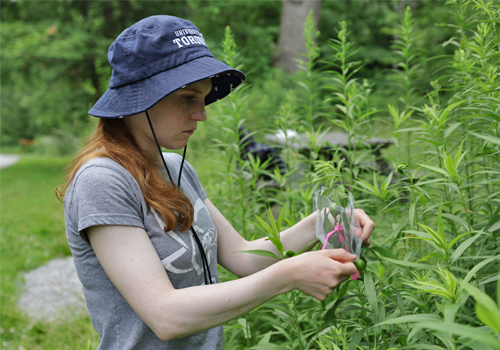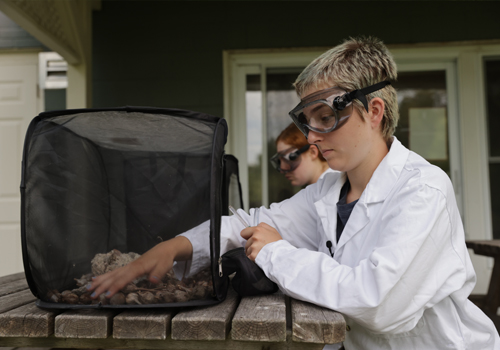When the pandemic ended in-person instruction at U of T in the spring of 2020, it also halted valuable experiential learning opportunities like the Faculty of Arts & Science’s Research Excursions Program (REP). The REP provides undergraduate students with a chance to take part in a faculty member’s research project off campus.
So, when pandemic restrictions eased and students returned to the classroom, they also returned to the field.
For their REP research project, Lily Peters and Abigail Wagner spent the summer at U of T’s Koffler Scientific Reserve at Joker’s Hill (KSR), located north of Toronto in a region of the province known as the Oak Ridges Moraine. The site comprises 350 hectares of wetlands, pastures and forests — and the wildlife that calls those habitats home — and is used by the University for research, training and public outreach.
The students were taking part in a study of the parasitic Goldenrod Gall fly and the common Goldenrod plant.
Peters, a member of Victoria College, is entering her second year in an ecology and evolutionary biology specialist program with a genome biology major. Wagner is entering her fourth year in a genome biology and physiology program and is a member of St. Michael’s College.
“This has been my first real experience doing research,” says Peters about why she chose the course. “I'm planning to do a master’s degree or PhD, so I wanted to see if research was for me and see what type of research I liked. I wanted to get a feel for how this type of research is done.”
Working outside in the field all day has been amazing. I’ve seen so many things — like my first porcupine! It’s been a really great experience that’s shown me how amazing field work is. It’s really solidified in my mind that this is what I want to do for the rest of my life.
“I'm really interested in genomics and eventually want to do genetic counseling,” says Wagner. “And our project is related to uncovering how different characteristics correlate with different gene variations and how common these variations are in a population — so it was just what I was looking for.”
Their REP supervisor is Arthur Weis, a professor in the Faculty of Arts & Science’s Department of Ecology & Evolutionary Biology. Weis studies natural selection — one of the mechanisms by which species evolve — in particular, when evolution occurs over a short period of time.

The Goldenrod fly is a parasite that lays its eggs on Goldenrod plants. After about ten days, a larva emerges from the egg and burrows into the plant’s stem, triggering the growth of a gall — a round, tumour-like sphere measuring a half-inch to an inch in diameter. The larva survives the winter inside the gall and in the spring, the adult fly emerges, ready to start the cycle over.
Peters and Wagner are helping Weis in his research into the genetic connection between individual flies and the size of the galls their larvae produce.
Gall size is important. Larvae in small galls are vulnerable to parasitic wasps that lay eggs in galls which then hatch into larvae that prey on the fly larvae. Larger galls offer protection from wasps but larger galls are preyed upon by woodpeckers for the larvae within. The researchers’ goal is to shed light on the natural selection forces that favour a gall that is neither too small nor too large — and the genes that may be the basis for determining size.
The students began by finding Goldenrod plants with galls. Their next step was to protect the fly larvae from wasps by wrapping the galls in mesh. Over the summer, Peters and Wagner “bagged” over 700 galls.
This is what it's all about — working with students in the lab or in the field. Students who are curious, enthusiastic and want to learn. And in the process, it extends my own research and helps me answer the questions I'm curious about.
The students then collected galls and sorted them by size.
“Next, we’ll sequence all the flies to figure out whether all the big-gall flies have a similar section of their genome,” says Wagner. “Then, we’ll look to see if some of the genes in this section play a role in causing a specific size of gall.”
For Weis, the REP is rewarding as both an instructor and a scientist.

“This is what it's all about — working with students in the lab or in the field,” he says. “Students who are curious, enthusiastic and want to learn. And in the process, it extends my own research and helps me answer the questions I'm curious about.”
For Wagner and Peters, the experience has provided them with much more than an opportunity to do research.
“It’s really added context for me for when I’m reading a research paper,” says Wagner. “Because now, I've experienced the entire research process, hands-on.”
“I'm planning to do a PhD,” says Peters, “so it's been cool seeing and talking with other researchers up here and learning about what they're doing for their masters and PhDs.
“And working outside in the field all day has been amazing,” she says. “I’ve seen so many things — like my first porcupine! It’s been a really great experience that’s shown me how amazing field work is. It’s really solidified in my mind that this is what I want to do for the rest of my life.”
The Research Excursions Program (REP) provides an opportunity for Arts & Science undergraduate students to travel off-campus in the summer term as part of an instructor’s research project, while earning course credit at the same time. Past REP courses have taken students around the world, including to archives in New York City, field sites in Algonquin Park and forests in Ecuador.

